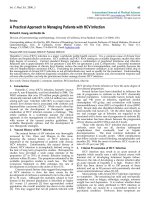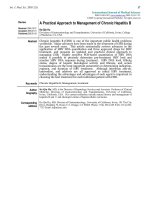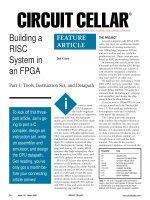Costs budgeting a practical approach in an uncertain regime
Bạn đang xem bản rút gọn của tài liệu. Xem và tải ngay bản đầy đủ của tài liệu tại đây (1.12 MB, 7 trang )
ARTICLE TWO – COSTS BUDGETING: A PRACTICAL APPROACH IN AN UNCERTAIN REGIME COSTS
Costs Budgeting: A practical
approach in an uncertain regime
Mathew Shankland (Partner) and Sarah Lainchbury (Associate) of Sidley Austin LLP
A
lthough costs budgeting has now been
supporting Practice Direction 3E. CPR 3.12 requires
in place for over 20 months, the detailed
parties to proceedings to file and exchange costs
implementation of the scheme is still
budgets in a specific format (‘Precedent H’) in all
Part 7 multi-track cases unless:
relatively untested” per Warby J in Yeo v Times
Newspapers Ltd [2015] EWHC 209 (QB).
• the claim is commenced after 22 April
2014 and the value of claim is more than
£10 million; or
The costs budgeting regime has been operating in
some form for almost three years. Its scope was
• the matter is subject to fixed or scaled costs
(prescribed by CPR 45, e.g. uncontested
cases, small claims and enforcement
proceedings); or
extended in April 2014 and now covers cases up to
£10 million in value. There are a number of issues
which should be considered by clients and their
practitioners in the cost budgeting process, and,
• where the Court, in its discretion, otherwise
orders.
while Yeo gave some much needed guidance on
the issues, the position remains unclear in many
respects. This article provides an overview of the
recent developments in case law and practical
The emerging position, however, is that the first two
advice for completion of the cost budget.
limitations should not be enforced too strictly and
should always be subject to the Court’s discretion.
The overriding factor to remember when preparing
See, for example, Coulson J’s comments in CIP
a cost budget is that if, at the conclusion of a case,
Properties v Galliford Try [2014] EWHC 3546 where
more costs are claimed than are budgeted for, they
he stated that, even where exceptions might apply,
will (probably) not be recoverable. It is, therefore,
the use of costs management should be considered
imperative to ensure that careful thought goes
and cost budgets are “generally regarded as a good
into preparing the budget in order that the risk of
idea and a useful case management tool”. In this case,
exceeding it in the future is minimised.
the Claimant had served a number of unexpected
expert reports, and the Defendant therefore made
an application for the costs budgeting regime
Application of the new
regime
to apply so as to preclude the Claimant from
conducting proceedings in the same costly manner
going forward.
The costs budgeting regime is governed by Section
In emphasising the importance of the Court’s
II of Part 3 of the Civil Procedure Rules (‘CPR’) and
discretion, Coulson J gave an example of a
8
ARTICLE TWO – COSTS BUDGETING: A PRACTICAL APPROACH IN AN UNCERTAIN REGIME COSTS
Precedent H
party “framing” their claims for simply £1
more than £10 million in order to avoid any
W
consideration by the Court of the proposed
costs
(no
matter
how
disproportionate
or inflated they may be). Accordingly, in
circumstances
where
the
value
of
here the regime applies, the entire
case must be budgeted unless
the Court orders otherwise. Clients
the
and practitioners should also bear in mind
claim itself is disputed, parties can, and, in
that, save in exceptional circumstances: (i)
appropriate cases, should apply for an order
the recoverable costs of initially completing
that costs budgeting apply. This is particularly
Precedent H shall not exceed the higher of
so where there is a risk that the costs of the
£1,000 or 1% of the approved budget; and (ii)
proceedings could become disproportionate to
all other recoverable costs of the budgeting and
the actual value of the claim1. As a matter of good
costs management process shall not exceed
practice, it is suggested that clients and their
2% of the approved budget.
practitioners consider proportionality of the
costs to the dispute from the outset. As we
Precedent H is broken down into eleven distinct
understand from Harbour, they have seen an
phases, each of which must include the parties’
increasing number of their £10 million plus cases
incurred costs (i.e. costs actually incurred including
being submitted to the costs budgeting process.
WIP) and estimated future costs.
9
“As a matter of good
practice, it is suggested
that clients and their
practitioners consider
proportionality of the
costs to the dispute
from the outset.”
10
ARTICLE TWO – COSTS BUDGETING: A PRACTICAL APPROACH IN AN UNCERTAIN REGIME COSTS
Making the right assumptions and planning
for contingencies
C
ompiling the estimated costs sections
of Precedent H is more challenging.
“Assumptions are
imperative in allowing
the Court and other
parties to understand
how the budget has
been created.”
It is not always clear what costs fall
within each of the distinct phases of Precedent
H. The Guidance Notes are instructive, but
the individual practitioner’s drafting approach
will, of course, vary. Under ‘Disclosure’, for
instance, the Guidance Notes provide that
“reviewing
documents”
and
“correspondence...
about the scope of disclosure and queries
arising” should be included in the figures for
that phase; however, sums in relation to any
application for specific disclosure are specifically
excluded from the estimated costs.
between the different options is therefore
It appears then that parties have three options:
fundamental to successful budgeting.
(i) to include an application for specific disclosure
Assumptions
as a ‘contingency’; (ii) to include an ‘assumption’
in relation to the scope of the opposition’s disclosure;
• Assumptions are imperative in allowing the
Court and other parties to understand how
the budget has been created and provides
a benchmark upon assessing the budget’s
reasonableness.
or (iii) revise the budget later down the line.
The distinction between each of these options
(whatever procedural aspect is being dealt
with) is important, and care should be taken
• Making good use of this feature appears to
give parties some scope to revise budgeted
figures later3.
when drafting and deciding which particular
option to pursue. Clients and practitioners
should pay close attention to the provisions
• Examples include: “there will be no (further)
amended pleadings”, “trial will be 5 days”,
“it is intended that witness evidence be
taken from X, Y and Z; if any potential witness
is unavailable when called upon the additional
expense involved in locating a new witness
can be reflected in a revised budget”.
of Practice Direction 3E and the relevant case
law which strongly suggests that parties should
not over-caveat with extensive assumptions2.
Any contingent costs which are included must
be anticipated and foreseen as more likely than
not to be required. Striking the right balance
1 This was the case in CIP Properties v Galliford Try [2014] EWHC 3546.
2 See, for example, Coulson J’s comments in CIP Properties where he noted that the excessive use of assumptions is a “wholly illegitimate
exercise in avoiding the certainty and clarity that comes from case management orders; it is designed to undermine the whole basis of such orders”.
11
ARTICLE TWO – COSTS BUDGETING: A PRACTICAL APPROACH IN AN UNCERTAIN REGIME COSTS
Contingencies
be included as a contingency “only if
it is foreseen as more likely than not to
be required”. He added that, “if work that
falls outside one of the main categories is
not thought probable, it can reasonably be
and should be excluded from the budget”.
Contingencies should therefore be drafted
clearly and realistically.
• A contingent cost is marked in Precedent
H as an additional phase and, according
to the Guidance Notes, must reflect
“anticipated costs” which do not naturally fall
within one of the pre-set phases.
• In Yeo, Warby J stated that work should
The importance of regularly reviewing the budget
C
lients and practitioners must conduct a
a cost which is not budgeted for becomes reasonably
regular review of all costs of the proceedings
likely to be incurred. Crucially, budgets should not
as they develop against the approved budget.
be revised after that cost is actually incurred as the
Revisions to budgets should be considered as soon as
risk is that the Court will not allow it4.
3 Clearly any application to vary the budget will be considerably assisted if parties are able to demonstrate that the reasonable assumptions
on which the budget is based have been departed from.
4See Venus Asset Management Limited v Matthews & Goodman LLP [2015] EWHC 2896 (Ch) which provides useful summary of the degree
of diligence required in this regard.
12
ARTICLE TWO – COSTS BUDGETING: A PRACTICAL APPROACH IN AN UNCERTAIN REGIME COSTS
In Venus Asset Management Limited, both parties
applied for retrospective revisions to their approved
“Cost budgeting is
becoming a core part of
the litigation process and
accurate forecasting is
therefore imperative.”
budgets on the basis that the costs actually incurred
were greater than the budgeted figures. In refusing
the application, Chief Master Marsh held that the
language used in the CPR clearly pointed to “the
court’s costs management powers being limited to
future costs”. Paragraph 7.3 of Practice Direction 3E
provides that the Court “will not undertake a detailed
assessment in advance”. Similarly, in the Commercial
Court Users’ Group Committee update dated 16
October 2015, on analysing recent developments
in case law (and, in particular, Yeo), HHJ Waksman
QC (Mercantile Court) noted that, where parties
have a costs budget and see an “overshoot looming”,
an application to revise the budget should be made
parties should utilise this provision and, should a
promptly and before the budgeted figure is exceeded.
“significant development” in the proceedings occur,
a revised budget should be prepared in line with
Pursuant to paragraph 7.4 of Practice Direction
paragraph 7.4 of Practice Direction 3E (which is
3E, if, by the time the costs management process
then agreed or approved).
takes place, substantial costs have been incurred,
the Court may “record its comments on those
Whether there is good reason to depart from the
costs” and the Court will “take those costs into
approved budget in any given case is likely to depend,
account
among other things, on how the proceedings have
when
considering
the
reasonableness
been managed, whether they have developed in a
and proportionality of all subsequent costs”.
way that was not foreseen when the relevant case
management orders were made, and whether the costs
Revising budgets for
unforeseen interim
applications
T
incurred are proportionate to what is in issue5.
In preparing a budget, parties should assume
that their opposition will comply with the CPR and
conduct proceedings in accordance with the order for
directions (making adverse assumptions about the
he
provisions
of
paragraph
7.9
of
opposition’s possible future behaviour are unlikely to
Practice Direction 3E state that, if interim
be viewed as justified). Equally, parties should not
applications are made which, reasonably,
include a contingency (for example, for an interim
were not included in a budget, then the costs
application) unless it is reasonably foreseeable. It
of such interim applications shall be treated as
is therefore suggested, in any event, that parties
additional to the approved budgets. Warby J in Yeo
use the provisions of paragraph 7.9 of Practice
also noted that, should the “improbable” occur,
Direction 3E in relation to interim applications.
13
ARTICLE TWO – COSTS BUDGETING: A PRACTICAL APPROACH IN AN UNCERTAIN REGIME COSTS
Proportionality and
approval of budgets
T
report must set out the figures which are agreed
and those which are not agreed for each phase
and a brief summary of the grounds of dispute.
he cases to date do not provide a
coherent approach to the questions of
Conclusions
reasonableness and proportionality in
budgeting terms. In Yeo, it was suggested that,
are reasonable and proportionate, it may also
P
be appropriate to consider the hourly rates and
assist parties in managing costs to resolution. Cost
number of hours claimed or forecast. In the
budgeting is becoming a core part of the litigation
authors’ experience, the usual judicial approach
process and accurate forecasting is therefore
is to focus more on the total costs claimed
imperative for the reasons set out above. The
than the detailed build up of that number (the
importance of proper costs budgeting for parties in
balance of cases support this). However, in all
all forms of litigation should not be underestimated.
whilst the Court’s primary consideration when
approving budgets is whether the total costs
proposed for each phase of the proceedings
roducing
a
proper
budget
can
more than the amount recoverable for it
under the CPR). Costs budgets can, however, greatly
cases, an objective approach should be taken
to consider whether the estimated costs can be
Matthew Shankland and Sarah Lainchbury
justified as reasonable and proportionate in the
Sidley Austin LLP
circumstances.
83rd update to the CPR,
April 2016
T
take
considerable time (and can, therefore, cost
he 83rd Update to the CPR Rules6 includes
important changes to the costs budgeting
regime. Notably, for all claims (irrespective
of value), where parties file and exchange budgets
they must also file an agreed budget discussion
report no later than seven days before the case
management conference. The budget discussion
5See Henry v News Group Newspapers Ltd [2013] EWCA Civ 3 and Murray & Anor v Neil Downlman Architecture Ltd [2013] EWHC 872 (TCC).
6 See: />
14









